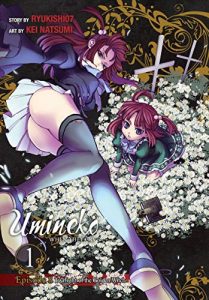Story by Ryukishi07; Art by Kei Natsumi. Released in Japan in three separate volumes as “Umineko no Naku Koro ni: Twilight of the Golden Witch” by Square Enix, serialized in the magazine Gangan Joker. Released in North America by Yen Press. Translated by Stephen Paul.
This is the final volume of Umineko: When They Cry, unless Yen licenses Tsubasa, which I suspect is about as likely as Hinamizawa Bus Stop. It’s a very good climax, essentially divided into two parts. the first is the “action finale”, showing off Ange and Battler doing battle with Erika and Bernkastel, with everyone getting a chance to kick some ass (even Krauss, in one of the funnier bits) and with Lambdadelta going above and beyond the call of duty, essentially sacrificing herself to save the siblings. Now, given we’re in the meta world, sacrificing yourself is not as permanent as it sounds, but it’s still quite heartfelt. From the sdtart, Lambda has been more interested in fun than Bernkastel, who just wants pain and suffering. (Of course, if the pain and suffering was fun, Lambda was all in.) We see another Higurashi flashback that reminds you of Lambda’s origins as Miyo Takano, though honestly there’s a lot of Satoko in her as well.
(It’s also my last chance to complain about Squeenix insisting on using “the first cover” every single omnibus, as it means we don’t get the awesome BeaBato final cover on the outside.)
The second half of the book is the aftermath, which faces up to the fact that most of the cast is dead, and that if Ange wants to have a future she’s going to have to “die” as well. Fortunately, if there’s one thing we’ve learned from Ryukishi07 it’s how words can be manipulated to mean multiple things. Ange erases her identity and lives on as a famous children’s author, who writes books essentially starring Maria and Sakutarou. (Well, mostly. This was based on a game, as you know, and the manga did include the game’s “bad end”, where Ange decides magic is a lie and kills everyone around her, earning praise from Erika. I appreciate the need for completeness, but it feels really out of place in the manga itself.) As a Higurashi fan, I must admit it’s very odd to see a nice, friendly Okonogi here. But then again he’s getting everything he wants. Certainly I’m sure he prefers dealing with Ange to dealing with Takano.
The other reveal is what we’d seen hints of this entire arc: Battler survived the tragedy as well. Well… sort of. One one last twist that combines the real life and the meta world, Touya (his new name) has a sort of amnesia – he recalls Battler’s life but doesn’t think of it as his own memories. This is why Ikuko’s books were so accurate. After a number of years (both are in middle age), Ange is finally invited to meet Touya and get the explanation, and Battler’s spirit is able to find peace (and separate itself from Touya). That said, the REAL ending of the book feels like the one with Battler and Beatrice, showing what really happened as they escape the mansion’s tragedy. Unfortunately, as we already know, this ends badly, as Beatrice/Sayo still can’t imagine Battler accepting her body and can’t forgive herself for coming up with a mass murder plan, even if she wasn’t the one doing the murders. It a gorgously bittersweet tragedy, that ends happily only provided you believe in magic.
So I think in the end Uminako manga readers will be very happy with this. Umineko visual novel fans may be slightly less happy, but this ended up being a story that needed to be told more tha a mystery that needed to be solved. Don’t be a goat. Enjoy Umineko.






